Travel Log, Recent Entries
CANADIAN MARITIME PROVINCES
New Brunswick
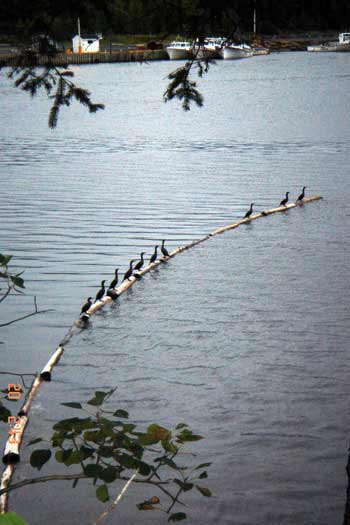 We continued west along the southern coast of the Gaspe Peninsula, finally crossing over into New Brunswick, a little sad to leave the beauty and robust spirit of Quebec. Two weeks before we'd arranged to have our mail sent to Bathhurst in northeast N.B., and it was time. Our last mail pickup was in Colorado Springs in early August, so we were looking forward to getting some good mail and our favorite magazines, along with the bills, urgent environmental alerts, solicitations to buy more stuff and offers to sell or refinance our home. Arriving at the post office, we were amazed that our mail hadn't arrived yet. We decided to stay overnight, but no luck the next day, either. Turns out international mail is often held in U.S. customs for up to ten days before being released to its destination. Homeland security. We eventually did receive the lost mail three weeks later in Calais, Maine! It had been returned to the states at the Canadian border for some unknown reason, was shipped back to our forwarding service in Texas, and then on to our next delivery site. We continued west along the southern coast of the Gaspe Peninsula, finally crossing over into New Brunswick, a little sad to leave the beauty and robust spirit of Quebec. Two weeks before we'd arranged to have our mail sent to Bathhurst in northeast N.B., and it was time. Our last mail pickup was in Colorado Springs in early August, so we were looking forward to getting some good mail and our favorite magazines, along with the bills, urgent environmental alerts, solicitations to buy more stuff and offers to sell or refinance our home. Arriving at the post office, we were amazed that our mail hadn't arrived yet. We decided to stay overnight, but no luck the next day, either. Turns out international mail is often held in U.S. customs for up to ten days before being released to its destination. Homeland security. We eventually did receive the lost mail three weeks later in Calais, Maine! It had been returned to the states at the Canadian border for some unknown reason, was shipped back to our forwarding service in Texas, and then on to our next delivery site.
Our forced stay in Bathhurst was surprisingly pleasant, even without our long-anticipated mail. It gave us a chance to have the oil changed and our tires rotated, always a treat (seriously!), and to take a walk through the unusual Daly Point Preserve at the edge of the bay, a place fertile with animal and plant life, especially mushrooms of all sizes and colors and curious chickadees which seemed eager to visit as they charmed us with their antics and song. We had a fabulous seafood dinner in nearby Nigerdoo, a place called La Fine Grope (sort of like "good grub") on a lovely cove on the Baie de Chaleurs. The owner, a jovial expatriated Frenchman, bought the land in the '70's and operates his restaurant year-around, even when icepack covers the bay as far as the eye can see. That's an image hard for a Californian to wrap his mind around. Bathhurst was reeling with the closure in August of a Smurfit-Stone corrugated cardboard container mill employing 267 people, which had been in operation since 1914. The depression in the town was palpable; even so, they were raising money for victims of Hurricane Katrina.
 Disappointed not to get our long-anticipated mail, we decided to drive on to the city of Moncton, the hi-tech and communications center of New Brunswick, where we hoped to find a wireless internet connection to catch up on our emails and reconnect with the outside world. Acting on a tip, we arrived at an "internet cafe" called Ground Zero in the heart of downtown. The sign led us down a darkened stairwell into a dank, dimly lit basement, walls painted black, smelling of smoke and bodies that could have benefited from a shower. The room was ringed with computer gaming stations, a few manned by teenaged boys slumped or slouched in seats, hands on joysticks, dilated pupils fixed on monitors. A poster on the drink cooler advertised an energy drink with the slogan "Never Sleep Again!" featuring an ergonomically-textured container for "when your hand starts to shake". The 14-year-old behind the counter said they didn't have wi-fi, but promised he could get us connected, $3 for thirty minutes, or $5/hour. Since we needed several hours and doubted whether this place was an ideal work environment for us or our laptops, we opted out of his offer and tried the local library instead. More promising, they had free terminals available for up to an hour, but all were occupied, with a waiting list. Calls to all the other businesses advertising internet access were unsuccessful. We had spent 4 hours in the communications capitol of New Brunswick, and not a connection to be had! Disappointed not to get our long-anticipated mail, we decided to drive on to the city of Moncton, the hi-tech and communications center of New Brunswick, where we hoped to find a wireless internet connection to catch up on our emails and reconnect with the outside world. Acting on a tip, we arrived at an "internet cafe" called Ground Zero in the heart of downtown. The sign led us down a darkened stairwell into a dank, dimly lit basement, walls painted black, smelling of smoke and bodies that could have benefited from a shower. The room was ringed with computer gaming stations, a few manned by teenaged boys slumped or slouched in seats, hands on joysticks, dilated pupils fixed on monitors. A poster on the drink cooler advertised an energy drink with the slogan "Never Sleep Again!" featuring an ergonomically-textured container for "when your hand starts to shake". The 14-year-old behind the counter said they didn't have wi-fi, but promised he could get us connected, $3 for thirty minutes, or $5/hour. Since we needed several hours and doubted whether this place was an ideal work environment for us or our laptops, we opted out of his offer and tried the local library instead. More promising, they had free terminals available for up to an hour, but all were occupied, with a waiting list. Calls to all the other businesses advertising internet access were unsuccessful. We had spent 4 hours in the communications capitol of New Brunswick, and not a connection to be had!

We did find a natural foods store, though, where they had good local organic butter, and espresso coffee from Cuba. Now we know that as good Americans, we're not supposed to buy anything from Cuba, much less travel there, but Rus couldn't help himself. He promised to use it all up by the time we recrossed the border.
By this time we were lonely for connection. Our desperation sparked a fierce determination to find the internet, or sink into..... well, never mind. After navigating Turtle through the crowded streets of bustling Moncton for several more hours, wearing our fingers out pressing the wifi finder, we found a motel which advertised free high speed wireless Internet, and asked at the desk if we could pay to park outside and connect to it for a few hours. The smiling young woman replied "Sure you can, but there's no charge". At last, we hooked up happily, later deciding to rent a room and sleep in a real bed after our orgy of Internet connectivity. (They allowed dogs too, what a great place!)
As you can see, we rely a lot on the Internet. It's our main means of staying in touch, we use it for banking, paying bills and even shopping. It's also an incomparable resource for information and a main source of news when we're in the U.S., since our national media has degenerated so badly. We've been enjoying Canadian newspapers and the CBC radio broadcasts, though; their high quality and independence have been a refreshing change.
Our impression of New Brunswick after 4 days of driving down the coast is of a place experiencing ecconomic challenges and seeking solutions, a place with lots of natural beauty, wild space, and down-to-earth, warm, friendly people.
To top of page
Nova Scotia
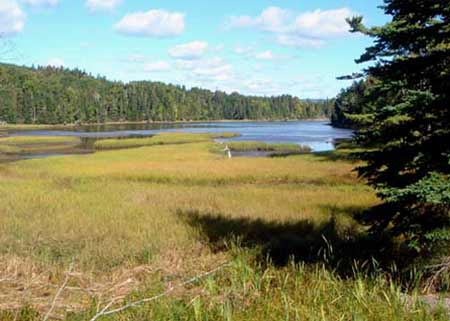 Next morning, made whole by our Internet extravaganza, we continued south, crossing into Nova Scotia, or Nouvelle Escosse, yet another distinct culture in this amazingly diverse country called Canada. Right away we noticed differences in geography, architecture, language, and culture. Passing through the town of Pugwash, the French/English signage disappeared, but here all the street signs were English/Gaelic! We landed in Tatamagouche, and have decided to stay for their Octoberfest, September 23-24, the second largest in Canada. It's in a big indoor arena with lots of music, dancing, food and drink. Sounds like fun. Next morning, made whole by our Internet extravaganza, we continued south, crossing into Nova Scotia, or Nouvelle Escosse, yet another distinct culture in this amazingly diverse country called Canada. Right away we noticed differences in geography, architecture, language, and culture. Passing through the town of Pugwash, the French/English signage disappeared, but here all the street signs were English/Gaelic! We landed in Tatamagouche, and have decided to stay for their Octoberfest, September 23-24, the second largest in Canada. It's in a big indoor arena with lots of music, dancing, food and drink. Sounds like fun.
Our arrival in Tatagamouche happened to be on the eve of the much-anticipated landfall of Hurricane Rita, at that time a class 5, and all the talk was again on the Gulf Coast of the U.S.. One of the owners of the campground, Dave, drove up to our rig, asked if we were following the news, and invited us over to his place to see the reports on CNN since we didn't have TV. We put on our boots, coats and hats and pushed through the wild wind and rain to his RV. Shortly, Dave and his wife took off to run a shuttle into town for the dance, telling us as they walked out the door, "Stay as long as you like, there's beer in the fridge."
We're getting used to this Canadian friendliness and hospitality, and hope to take some with us to spread around back home. The Canadians we've met, both Francophone and Anglophone, have been universally welcoming and hospitable to us Americans, even though they're just as universally appalled by the Bush administration. Rather than holding ordinary Americans responsible (which perhaps they should), they seem instead to be sympathetic.
As each other's primary trading partner, the two countries are joined at the hip economically, but culturally the differences become quite apparent when you spend a little time here. There are many cultures co-existing in Canada: English, French, Scottish, Irish, Acadian, German, Italian, and more recently Chinese, to name a few. Many Quebeqois consider themselves first Quebeqois, then Canadians, and even the English-speaking cultures remain proudly intact and distinct, though they consider themselves Canadians first. Flying their flags as a statement of their separatist attitudes (Quebeqois) or of their proud heritage (Acadian), we counted many provincial flags displayed outside homes, flying solo. The flags on one block told a story, 3 homes flew the flag of Quebec alone, next to a house flying the blue of Quebec below the Canadian red maple. All this creates a rich stew of humanity, lots of things to work out, lots of tolerance required. Our limited experience leads us to think that average Canadians are better educated and informed, more intellectually awake, and more tolerant of diversity than their neighbors to the south. There is also far less poverty here, and far less crime (could there be a relationship?). They also have universal health care, if you were looking for another reason to like Canada. No wonder so many young American men came here in the '60's and '70's to avoid "serving" in the Viet Nam war, and never went back.
 The 26th annual Tatagamouche Octoberfest was packed by early afternoon, the leiderhosened polka band in full swing, dance floor crowded, long tables groaning with beer pitchers, wine bottles, elbows and plates of wurst, schnitzel and other stuff you probably shouldn't eat unless you're driving a dogsled. We danced a couple of polkas, then got in line for some of what they call in Canada "smoked meats". Rus heaped his plate with everything they had, and even Kathleen, a (fish eating)vegetarian, couldn't resist a schnitzel, though it was mostly the sauerkraut she was after. The food was good. Really good. Especially to Rus, whose cholesterol level had been dipping dangerously low. Kathleen was feeling a bit under the weather, though, even before her schnitzel, and didn't want to hang out any longer, so it was back on the road in the direction of Nova Scotia's famous Cape Breton, actually a large island making up the northeastern part of the province, and the easternmost part of our journey. We'd been on Atlantic Time for weeks now, 4 hours ahead of California. It's hard to find a good time to call home. The 26th annual Tatagamouche Octoberfest was packed by early afternoon, the leiderhosened polka band in full swing, dance floor crowded, long tables groaning with beer pitchers, wine bottles, elbows and plates of wurst, schnitzel and other stuff you probably shouldn't eat unless you're driving a dogsled. We danced a couple of polkas, then got in line for some of what they call in Canada "smoked meats". Rus heaped his plate with everything they had, and even Kathleen, a (fish eating)vegetarian, couldn't resist a schnitzel, though it was mostly the sauerkraut she was after. The food was good. Really good. Especially to Rus, whose cholesterol level had been dipping dangerously low. Kathleen was feeling a bit under the weather, though, even before her schnitzel, and didn't want to hang out any longer, so it was back on the road in the direction of Nova Scotia's famous Cape Breton, actually a large island making up the northeastern part of the province, and the easternmost part of our journey. We'd been on Atlantic Time for weeks now, 4 hours ahead of California. It's hard to find a good time to call home.
Cape Breton, Nova Scotia
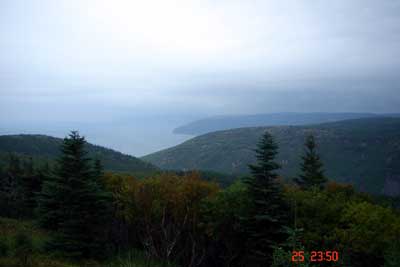 Everyone tells you to see Cape Breton. They oooh and aaah, so, of course, we wanted go. Arriving in a rain storm we found ourselves alone in MacIntosh Brook Campground at Cape Breton Highlands National Park. It got colder and rained harder, with more bad weather in the forecast. After 4 months on the road, rain is just one of those things you deal with, but still, those spectacular vistas we'd heard so much about had fogged over and vanished into a deeply penetrating grey. That didn't stop us though, Kathleen insisted we don our rain gear and hike through the hardwood forest to MacIntosh Falls. It was a wonderful hike in the pouring rain, and we stayed warm by moving. To dry out we were happy to use a cozy building in the center of the campground called a "kitchen shelter". Most Canadian Parks in these parts have shelters and, like most, this one was equiped with tables and benches, sinks for washing, a big wood stove in the middle of the room and a bin full of split firewood. (So thoughtful!) We've got a nice fire going, the dogs are curled up next to the stove, and we hung our wet clothes out to dry. The room smelled fragrant with its walls and ceiling of unfinished pine. We both took the opportunity to do a little work on our computers, until a tour bus pulled up to use the shelter for a lunch break. Everyone tells you to see Cape Breton. They oooh and aaah, so, of course, we wanted go. Arriving in a rain storm we found ourselves alone in MacIntosh Brook Campground at Cape Breton Highlands National Park. It got colder and rained harder, with more bad weather in the forecast. After 4 months on the road, rain is just one of those things you deal with, but still, those spectacular vistas we'd heard so much about had fogged over and vanished into a deeply penetrating grey. That didn't stop us though, Kathleen insisted we don our rain gear and hike through the hardwood forest to MacIntosh Falls. It was a wonderful hike in the pouring rain, and we stayed warm by moving. To dry out we were happy to use a cozy building in the center of the campground called a "kitchen shelter". Most Canadian Parks in these parts have shelters and, like most, this one was equiped with tables and benches, sinks for washing, a big wood stove in the middle of the room and a bin full of split firewood. (So thoughtful!) We've got a nice fire going, the dogs are curled up next to the stove, and we hung our wet clothes out to dry. The room smelled fragrant with its walls and ceiling of unfinished pine. We both took the opportunity to do a little work on our computers, until a tour bus pulled up to use the shelter for a lunch break.
Cape Breton rocks are spectacular
 |
 |
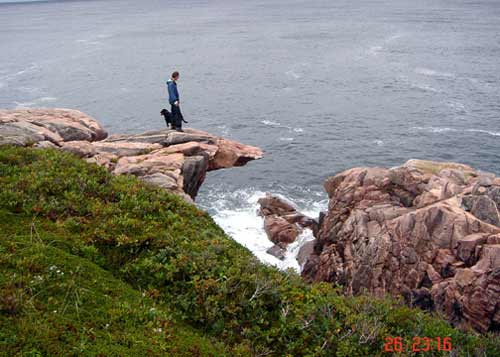
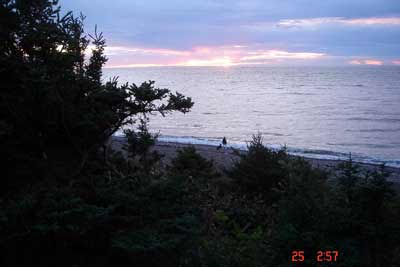
Cape Breton lived up to it's reputation, when we finally caught glimpses of it through the fog and mist. There are a lot of Scots in the area, at one time the largest concentration outside Scotland. There are also lots of Acadians, the mostly French equivalent of New Englanders, who occupied Cape Breton (then called Ile Royale) for generations, but were expelled beginning in 1755 on the eve of the Seven Years War. The Acadians refused to sign a loyalty oath to either Britain, who controlled Nova Scotia at the time, or with France, their country of origin. To do so would have meant they would have been conscripted to fight on whichever side they had sworn loyalty to. So the British, distrustful of the Acadians' neutrality, decided to expel them and to seize all their holdings. Most were deported to France or to the New England colonies, but some also fled to Quebec, to Louisiana, or to the Antilles. Some also hid out in the remote parts of the island. The name Cajun is simply a contraction of Acadian, and many Acadians still have close family ties with Cajuns in Louisiana. As deportees, they were often unwelcome wherever they were sent, and frequently were re-deported or moved themselves to escape miserable conditions. Their story is one of the tragedies of common people living their lives, victimized by political struggles they had no stake in, and they might have faded into history had it not been for Longfellow's epic 1847 poem "Evangeline", which we all read in high school and promptly forgot, but which ignited worldwide attention to the plight of the Acadians nearly a century before. Learning all this, it suddenly dawned on Rus that a song he's known for many years, "Un Canadien Errant" (a wandering Canadian), is about the Acadian Expulsion, and indeed, he later learned the original title was "Un Acadian Errant". Traveling connects some dots and creates others. Here once again, signs are both in English and French. You're as likely to hear one spoken as the other, and everyone seems to speak both. We've never seen such a large population of bilingual people.
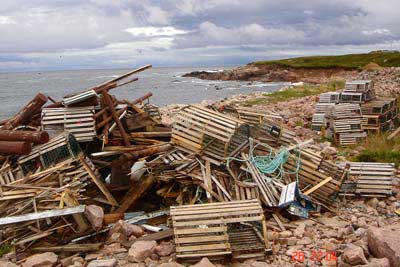 Returning from dinner in the town nearby, we found our kitchen shelter occupied by a group of about 8 guys milling around inside. Rus and Ziggy went over to say hello. They were moose hunters, Nova Scotia Acadians finished with their day's hunt, cooking up a big pot of fish chowder. They invited Rus to have a bowl, and it was delicious, even after the big dinner he'd just finished. The chowder chef was a haddock fisherman, and at least three others were lobstermen: grandfather, father, and grandson. They all spoke English as well as we do, then would switch to an almost unintelligible version of French when speaking among themselves. They said it wasn't really French, but a dialect similar to Cajun. Rus plied them with questions about the lobster fishery, the Acadians, and moose hunting. He could have listened to them all night, but it was nearly 11:00 and they had to get up at 4:00 for tomorrow's hunt. It was fun spending some time with these interesting and generous men, the evening made even richer for getting that fish chowder recipe which we made a few days later. Returning from dinner in the town nearby, we found our kitchen shelter occupied by a group of about 8 guys milling around inside. Rus and Ziggy went over to say hello. They were moose hunters, Nova Scotia Acadians finished with their day's hunt, cooking up a big pot of fish chowder. They invited Rus to have a bowl, and it was delicious, even after the big dinner he'd just finished. The chowder chef was a haddock fisherman, and at least three others were lobstermen: grandfather, father, and grandson. They all spoke English as well as we do, then would switch to an almost unintelligible version of French when speaking among themselves. They said it wasn't really French, but a dialect similar to Cajun. Rus plied them with questions about the lobster fishery, the Acadians, and moose hunting. He could have listened to them all night, but it was nearly 11:00 and they had to get up at 4:00 for tomorrow's hunt. It was fun spending some time with these interesting and generous men, the evening made even richer for getting that fish chowder recipe which we made a few days later.
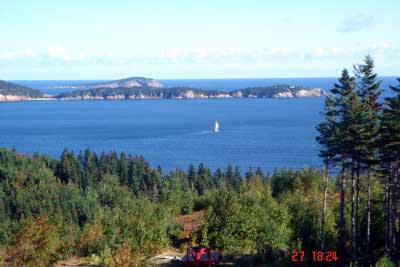 Leaving Cape Breton National Park we were treated to glorious weather and spectacular views of stunted forests atop rocky seascapes, of rugged mountains jutting into the blue Atlantic, of soft grassy marshlands and picturesque bayside villages. We passed a group of men skinning a moose on the side of the road, a sight we won't forget soon. And coming around to the southeastern shore of the island we slipped 250 years back into history at Fort Louisbourg, Canada's largest historical reconstruction. For the first half of the 18th century, Fort Louisbourg was the primary defensive outpost for France's holdings in North America, and the site of an important cod fishing industry as well, supplying many of France's faithful Catholics with the dried and salted cod they were obliged to eat about 150 days of each year. No wonder Europeans had fished out the Mediterranean and their own Atlantic coast early on! Leaving Cape Breton National Park we were treated to glorious weather and spectacular views of stunted forests atop rocky seascapes, of rugged mountains jutting into the blue Atlantic, of soft grassy marshlands and picturesque bayside villages. We passed a group of men skinning a moose on the side of the road, a sight we won't forget soon. And coming around to the southeastern shore of the island we slipped 250 years back into history at Fort Louisbourg, Canada's largest historical reconstruction. For the first half of the 18th century, Fort Louisbourg was the primary defensive outpost for France's holdings in North America, and the site of an important cod fishing industry as well, supplying many of France's faithful Catholics with the dried and salted cod they were obliged to eat about 150 days of each year. No wonder Europeans had fished out the Mediterranean and their own Atlantic coast early on!
The Gates of Fortress Louisbourg A chaloupe and cod flake racks outside the fort
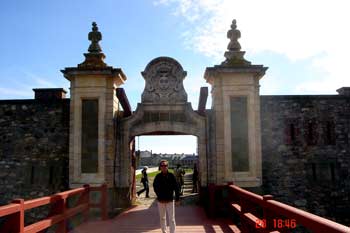 |
 |
Fort Louisbourg in the early- to mid-1700's was a thriving town of around 3000, bigger than any of the surrounding towns even today, with many soldiers, fishermen, merchants, tradesmen and servants, also a steady transient population due to the shipping port. About 20% of the original buildings and fortifications have been reconstructed, using the original plans and records so meticulously kept by the French during that period. Every document, including architectural drawings, was done in triplicate: one to Paris, one to Quebec, and one for the location it pertained to; so the reconstruction team in the 1960's had at their disposal an almost complete history of every building in the town, even though everything had been reduced to rubble by the British 200 years before, when they abandoned the fort.
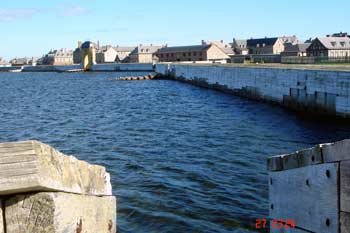 The Fort is a living history exhibit: people in period clothes are everywhere in various roles, some as specific people who had actually lived there at the time, engaging you in conversation as if it were really 1744, or slipping out of their roles to answer questions. You're free to wander among the homes, storehouses, workshops and quarters, and there's even an inn where only 18th century food and drink is served. The attention to historical detail in the construction and presentation of this place was impressive; we spent many fascinating hours poking our noses into corners and questioning the "inhabitants" about their lives. In 1758, Fort Louisbourg ultimately fell into the hands of the British in the Seven Years War, after which France lost most of its territory in eastern Canada, but kept Quebec. The northeastern geography of the U.S. would look a little different had France won, as northern Maine was part of its holdings, and is still rich with French heritage. The English and the French were keen competitors for the abundant resources of the New World, but the well-established English colonies in New England, with their agricultural and manufacturing resources as well as their militias, helped give England the edge, and so we have our world as it is today. National boundaries have always shifted in response to events, though, and it's fun to imagine what the future may have in store for the North American continent. The Fort is a living history exhibit: people in period clothes are everywhere in various roles, some as specific people who had actually lived there at the time, engaging you in conversation as if it were really 1744, or slipping out of their roles to answer questions. You're free to wander among the homes, storehouses, workshops and quarters, and there's even an inn where only 18th century food and drink is served. The attention to historical detail in the construction and presentation of this place was impressive; we spent many fascinating hours poking our noses into corners and questioning the "inhabitants" about their lives. In 1758, Fort Louisbourg ultimately fell into the hands of the British in the Seven Years War, after which France lost most of its territory in eastern Canada, but kept Quebec. The northeastern geography of the U.S. would look a little different had France won, as northern Maine was part of its holdings, and is still rich with French heritage. The English and the French were keen competitors for the abundant resources of the New World, but the well-established English colonies in New England, with their agricultural and manufacturing resources as well as their militias, helped give England the edge, and so we have our world as it is today. National boundaries have always shifted in response to events, though, and it's fun to imagine what the future may have in store for the North American continent. 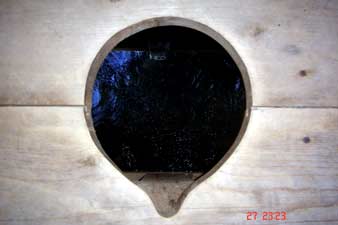
Louisbourg's Community Sanitation solution >
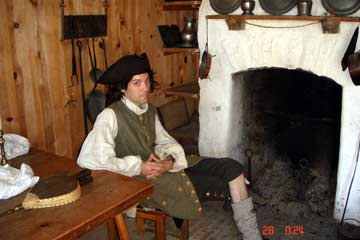
A couple of interesting food details: lobster was considered almost an aquatic insect, eaten only by the very poorest people, until the late 1800's, when a modest fishery began for them. They were used mostly as fertilizer in the gardens of the early French and English colonists. Potatoes, too, were grown mostly for livestock feed, eaten only by the poor. French colonists at the time ate bread, which had to be made from flour imported from Europe, as it was prohibited for them to grow their own grain. It was part of a complex economic structure designed to keep colonists dependent upon the mother country for basic needs. Their role was to supply raw materials to the homeland, and to be consumers of finished goods shipped back. Although a few became very wealthy under this system, most people found the deck stacked against them, and barely subsisted or lived in constant debt and servitude. Plus ca change........
To top of page
Halifax, Nova Scotia
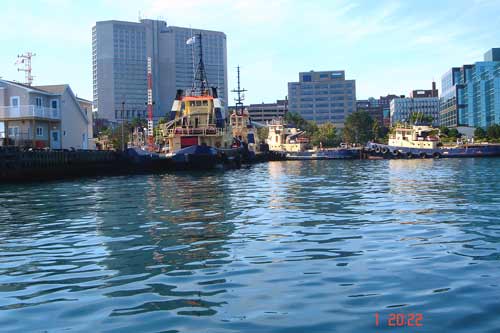 Halifax was the next port of call, and some port it is, the world's second biggest deepwater port next to Sydney, Australia, with container ships, naval and coast guard ships, cruise ships, tugs and barges, sailboats and powerboats moving in and out of the harbor 24 hours a day. Halifax is the closest North American port for ships sailing from Europe, so in times of war it's been a busy place. Halifax was also the closest port to the Titanic disaster in 1912; and became the base for the rescue effort; some 120 of the dead are still buried there. In 1917 the town had its own disaster when a ship with a massive cargo of explosives collided with another ship in mid-harbor, caught fire, drifted to shore and exploded, killing some 2000 people and demolishing a major portion of the town. The anchor from that ship was found 18 kilometers away, just to give you an idea. A large part of town just disappeared, and that accounts for its more modern appearance relative to other cities of the same age. Halifax was the next port of call, and some port it is, the world's second biggest deepwater port next to Sydney, Australia, with container ships, naval and coast guard ships, cruise ships, tugs and barges, sailboats and powerboats moving in and out of the harbor 24 hours a day. Halifax is the closest North American port for ships sailing from Europe, so in times of war it's been a busy place. Halifax was also the closest port to the Titanic disaster in 1912; and became the base for the rescue effort; some 120 of the dead are still buried there. In 1917 the town had its own disaster when a ship with a massive cargo of explosives collided with another ship in mid-harbor, caught fire, drifted to shore and exploded, killing some 2000 people and demolishing a major portion of the town. The anchor from that ship was found 18 kilometers away, just to give you an idea. A large part of town just disappeared, and that accounts for its more modern appearance relative to other cities of the same age.
 Halifax also has North America's oldest continually operating brewery, the Alexander Keith Brewery, founded in 1835, a source of pride as well as beer to most Nova Scotians. "Those who like it, like it a lot" is their motto. Halifax also has a fabulous farmers market in the old Keith Brewery on Saturday mornings, a perfect place to re supply our fridge. You enter the old stone building through a big metal door. The walls of the entry had knee-high grooves in them made by the hubs of wagon wheels which had for many years carried supplies in and brew out on the way to market. An enclosed courtyard was crammed with stalls and people, piled with colorful organic produce, flowers, plants, crafts and art for sale. A maze of hallways and small rooms lead upstairs and down, leading to booths selling everything from sausages, beef and kidney pies, shellfish pies, tofu vegetable pies, to all kinds of baked goods, and grains and flour mixtures. Musicians squeezed into corners to play for tips, gathering onlookers that make the maze harder to navigate. We sampled a cup full of deliciously seasoned scallops browned in a wok, and then went back for more. We bought more produce than we had room for, handmade soap lined with rose buds, and a handmade Christmas ornament from an angel of a woman who raised and sheered her own sheep on her homestead several hours drive to the north. A fun morning! Halifax also has North America's oldest continually operating brewery, the Alexander Keith Brewery, founded in 1835, a source of pride as well as beer to most Nova Scotians. "Those who like it, like it a lot" is their motto. Halifax also has a fabulous farmers market in the old Keith Brewery on Saturday mornings, a perfect place to re supply our fridge. You enter the old stone building through a big metal door. The walls of the entry had knee-high grooves in them made by the hubs of wagon wheels which had for many years carried supplies in and brew out on the way to market. An enclosed courtyard was crammed with stalls and people, piled with colorful organic produce, flowers, plants, crafts and art for sale. A maze of hallways and small rooms lead upstairs and down, leading to booths selling everything from sausages, beef and kidney pies, shellfish pies, tofu vegetable pies, to all kinds of baked goods, and grains and flour mixtures. Musicians squeezed into corners to play for tips, gathering onlookers that make the maze harder to navigate. We sampled a cup full of deliciously seasoned scallops browned in a wok, and then went back for more. We bought more produce than we had room for, handmade soap lined with rose buds, and a handmade Christmas ornament from an angel of a woman who raised and sheered her own sheep on her homestead several hours drive to the north. A fun morning!
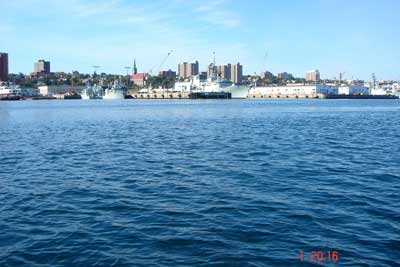 Acting on a tip from locals we splurged on a fancy dinner at the Five Fisherman which offers an all-you-can-eat mussel bar, free with any entree. The mussels were fresh and deliciously prepared with a choice of 3 or 4 dipping sauces. We were full and happy after the bar, and could have stopped right there, but we had to eat the entree (lobster for Kathleen, steak for Rus). In such a lively, social atmosphere where every preparation seemed carefully attended to, the meal flowed leisurely on, becoming one of the most memorable dinners we've had so far. After strolling around the city streets and getting a feel for Saturday night in Halifax we had a pint in a nearby pub, listening to a three piece band named Clam Chowder, two acoustic guitars and a bass, doing traditional songs with harmonies so tight Rus had to go see them on their break. Turned out they were all related to each other, and had played music together for 18 years, since they were kids. A hearty, bustling and comfortable city, we got to know it well on foot, and it won our hearts. The waterfront is beautifully lined with walks and plazas, cafes have outdoor seating, and street performers entertain the walkers-by as Harbor Hopper tour vehicles hustle about. We discovered that the parking lot near the marina had free wifi and we made it our home base for several days. Making plans to live in Halifax in some future lifetime, we bid it a fond farewell. It was time to move on. Acting on a tip from locals we splurged on a fancy dinner at the Five Fisherman which offers an all-you-can-eat mussel bar, free with any entree. The mussels were fresh and deliciously prepared with a choice of 3 or 4 dipping sauces. We were full and happy after the bar, and could have stopped right there, but we had to eat the entree (lobster for Kathleen, steak for Rus). In such a lively, social atmosphere where every preparation seemed carefully attended to, the meal flowed leisurely on, becoming one of the most memorable dinners we've had so far. After strolling around the city streets and getting a feel for Saturday night in Halifax we had a pint in a nearby pub, listening to a three piece band named Clam Chowder, two acoustic guitars and a bass, doing traditional songs with harmonies so tight Rus had to go see them on their break. Turned out they were all related to each other, and had played music together for 18 years, since they were kids. A hearty, bustling and comfortable city, we got to know it well on foot, and it won our hearts. The waterfront is beautifully lined with walks and plazas, cafes have outdoor seating, and street performers entertain the walkers-by as Harbor Hopper tour vehicles hustle about. We discovered that the parking lot near the marina had free wifi and we made it our home base for several days. Making plans to live in Halifax in some future lifetime, we bid it a fond farewell. It was time to move on.

To top of page
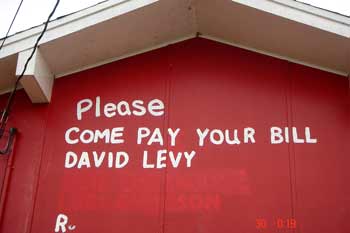
Bay of Fundy Coast
We wanted to see the Fundy Coast, which has the world's highest (or is it lowest?) tides. Whichever, the spread between high and low is usually about 29 feet, and can be as much as 48 depending on the tide and where you are. At low tide, the inlets become deep, muddy ravines cut into the landscape. Fishing boats in the harbors sit high and dry on the mud between tides, and it's hard to believe they'll be floating again in just a few hours. Hiking out to the tip of Cape Split, a sliver of land separating the Bay of Fundy from Minas Basin, we saw some tremendous hydraulics as Fundy, still emptying, met the incoming tide from Minas Basin. This happens 3 1/2 hours before each high tide, only on this one point. With churning rapids, standing waves and whirlpools, this section looks like a huge stretch of whitewater in the middle of the ocean. It's a heady feeling to brace against the wild force of wind on that tip of crumbling cliff and watch the action far below.
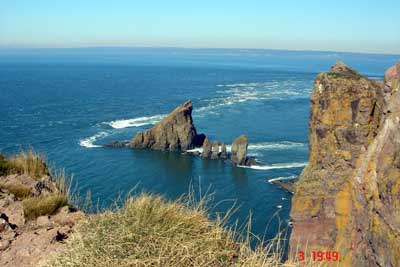 The nearby town of Wolfville, home of Acadian University, is also near the headquarters of a Fair Trade coffee company called Just Us, whose coffee we've been seeing for sale at the better markets we've stopped at throughout Eastern Canada. We spent several hours in their cafe, hooked up to their good wi-fi signal, catching up on our correspondence before heading for parts unknown. An older woman at a nearby table was giving an interview to a group of college students and was espousing her social and political views within earshot of Kathleen (Rus was oblivious, as usual). Hearing her biting and blanket criticism of the United States made Kathleen's hackles rise up. She was surprised by her reaction because, actually, she agreed with much of of what this woman said, but her dismissive tone caught her off guard. Rus remembers a friend who went to the USSR in the 80's on a friendship-building mission, and how offended he was hearing America criticized by the Russians he met, though he had little disagreement. He said it was like hearing someone else complain about the same beefs you had about your wife! The nearby town of Wolfville, home of Acadian University, is also near the headquarters of a Fair Trade coffee company called Just Us, whose coffee we've been seeing for sale at the better markets we've stopped at throughout Eastern Canada. We spent several hours in their cafe, hooked up to their good wi-fi signal, catching up on our correspondence before heading for parts unknown. An older woman at a nearby table was giving an interview to a group of college students and was espousing her social and political views within earshot of Kathleen (Rus was oblivious, as usual). Hearing her biting and blanket criticism of the United States made Kathleen's hackles rise up. She was surprised by her reaction because, actually, she agreed with much of of what this woman said, but her dismissive tone caught her off guard. Rus remembers a friend who went to the USSR in the 80's on a friendship-building mission, and how offended he was hearing America criticized by the Russians he met, though he had little disagreement. He said it was like hearing someone else complain about the same beefs you had about your wife!
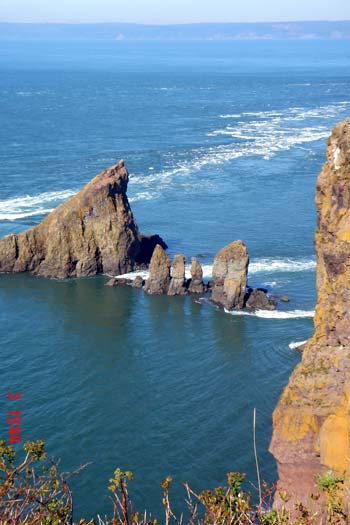 Before leaving Nova Scotia, we had to see the National Historic Site of the Acadians, in nearby Grand Pre. This fertile area, reclaimed from salt marsh by the Acadian farmers, using an ingenious system of dikes and levees and one-way drainage valves, was a center of Acadian culture for a hundred years until the "Grand Derangement", or the Expulsion that occurred between 1755-63. This place has become the Acadian spiritual home, and each year their descendants gather by the thousands from all over the world to celebrate a culture that refuses to die. We engaged one of the guides in conversation, a man who spoke wonderful English as well as his native French, listening in amazement as he outlined the odyssey of one Acadian family removed from Beau Pre in 1755, and deported eleven more times before finally settling in Newfoundland in a place so remote no-one knew or cared that they were there. They are there still. Kathleen, a keen observer of emotion, saw tears coming to his eyes twice as he recounted their story of suffering and endurance. The passion of this gentle man was palpable, the story of the deportation so sad; it created a rich and emotional experience for both of us. Before leaving Nova Scotia, we had to see the National Historic Site of the Acadians, in nearby Grand Pre. This fertile area, reclaimed from salt marsh by the Acadian farmers, using an ingenious system of dikes and levees and one-way drainage valves, was a center of Acadian culture for a hundred years until the "Grand Derangement", or the Expulsion that occurred between 1755-63. This place has become the Acadian spiritual home, and each year their descendants gather by the thousands from all over the world to celebrate a culture that refuses to die. We engaged one of the guides in conversation, a man who spoke wonderful English as well as his native French, listening in amazement as he outlined the odyssey of one Acadian family removed from Beau Pre in 1755, and deported eleven more times before finally settling in Newfoundland in a place so remote no-one knew or cared that they were there. They are there still. Kathleen, a keen observer of emotion, saw tears coming to his eyes twice as he recounted their story of suffering and endurance. The passion of this gentle man was palpable, the story of the deportation so sad; it created a rich and emotional experience for both of us.
It was finally time to leave Nova Scotia. As it was raining, we decided on the night crossing from Digby, the "Scallop Capitol of the World", to St. John, just the "capitol" of New Brunswick. Before boarding, we had time to walk out to the Digby docks and watch a scallop boat unloading its catch. The buyers were waiting with their scales, the fueling truck was there to pump enough diesel into the tanks for the next 4-5 day trip, and the fishermen's wives and girlfriends came to welcome them home (and find out how the fishing was). Stacked in the hold were bags upon bags of shucked scallops, each one about 10 kilos, packed in ice. It must have been a good trip, as the skipper told his wife he was taking the crew out for a few beers before coming home. This was a scene that had been repeated, with variations in technology, for many years in Digby, and for thousands of years around the world. It looked like a good life, at least from our end.

< a romantic farmer, "Lise marry me"
The ferry docked around midnight, so we slept there in the empty parking lot before venturing into the city in the morning. St. John was a center for Loyalists in the years before and after the American Revolution. Loyalists were colonists whose loyalty remained with the Crown of England, and wanted the Colonies to remain under British rule. This was usually not for ideological reasons, but rather because they had some position or property, or both, that was dependent on the status quo. Imagine trying to sell the idea of revolution these days to Federal employees, and you get an idea why there were so many Loyalists. As tensions between Britain and the Colonies increased and the Revolution built steam, many Loyalists fled to Canada. Many others, who had waited to see how things would turn out, fled afterwards. Rus is currently reading Howard Zinn's A People's History of the United States, a study of American history from the perspectives of everyday people, which deals extensively with the Colonial period. Many already wealthy landowners and merchants profited enormously from the Revolution, but for most common white men, their lives after the Revolution (if they weren't killed), were pretty much the same as before. Everyone else, which was the vast majority, including all women, servants, slaves and Indians, would have been hard-pressed to find anything that had changed. In this light, the Loyalists don't look so bad; their side just lost.
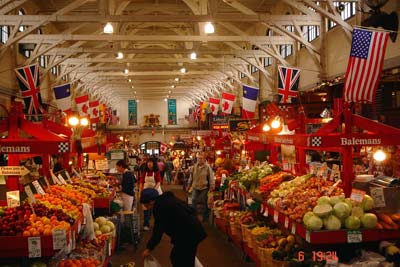 We visited the marketplace in St. John, bought some gifts for people back home, then drove reluctantly for the border, re-entering the U.S. at Calais, Maine, after six weeks in eastern Canada. At customs, Rus relinquished the bangers (English style sausages) he'd bought at the Halifax Farmer's Market because he couldn't prove they didn't have any beef in them, and we were on our way. We visited the marketplace in St. John, bought some gifts for people back home, then drove reluctantly for the border, re-entering the U.S. at Calais, Maine, after six weeks in eastern Canada. At customs, Rus relinquished the bangers (English style sausages) he'd bought at the Halifax Farmer's Market because he couldn't prove they didn't have any beef in them, and we were on our way.
Although we had diligently prepared international travel papers for the dogs and had them out and handy at each border crossing, we were never asked for them. In fact, no one seemed to care about the dogs. Rus still complains about those bangers, though. |

